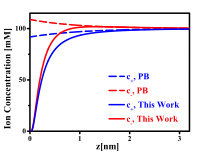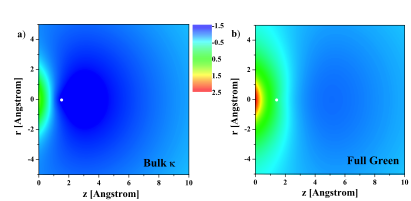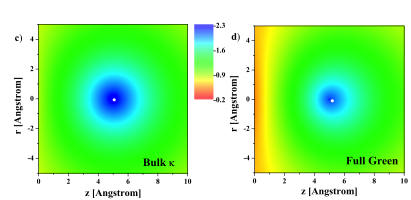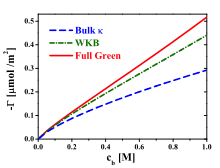Reports: ND553404-ND5: Effects of Ions on Interfacial Tension and Electrical Double Layer
Zhen-Gang Wang, California Institute of Technology
Our efforts during the last reporting period focused on two aspects of this problem: (1) a nonperturbative theory for image charges in the double layer structure for weakly charged interfaces; (2) inhomogeneous screening near a dielectric interface.
Figure 1. Ion concentration for a 1:1 electrolyte solution near a dielectric interface. The dielectric constants of the solvent and the plate are respectively eS=80, eP=2.5 and charge density s=1e/100nm2. The dashed lines are predictions of the PB theory and the solid lines are results of our work.
The markedly different concentration profile predicted by our new theory results in qualitatively new effects not captured by the PB theory. In bulk, screening is commonly manifested as an exponential damping of the long-range Coulomb interactions between two test charges. When the ion distribution is nonuniform, as in the vicinity of a charged surface or an interface with dielectric discontinuity, screening also becomes inhomogeneous. The inhomogeneous screening of the fixed surface charge by the mobile ions is accounted for, at the mean-field level, by the Poisson-Boltzmann theory; however, the inhomogeneous screening of the interactions between mobile ions as well as between a mobile ion and its own image charge has not been fully examined. Figure 2. Non-divergent part of the electrostatic potential generated by a test charge in a 1:1 electrolyte solution near a dielectric interface of lower dielectric constant. The test ion is at 0.15nm from the surface for a) and b) and is at 0.5nm for c) and d). The left figures are results using the bulk screening approximation and the right figures are results from our numerical solution of the full Green function.
The prevalent treatment of screening of interactions between ions and between an ion and its own image in an inhomogeneous system relies on ad hoc approximations, such as the WKB and the bulk screening approximation. Of these two, the bulk approximation is by far the most commonly used. The validity of, and the errors introduced by, these approximate schemes have never been elucidated.
We systematically addressed the effects of inhomogeneous screening for an electrolyte solution near a dielectric interface. The inhomogeneous ion concentration has two consequences for screening: the lower ionic strength near the interface results in less screening on the image force, and the depletion zone has a long-range and accumulative effect on screening, extending the range of the depletion layer; Figure 2 shows the potential generated by a test charge near a neutral dielectric surface. Consequently, the ion distribution is significantly affected. The inhomogeneous screening effect becomes more pronounced in less polar solvent and for ions of higher valency. The importance of our work is both conceptual and practical. For example, on the conceptual side, our work shows that the image charge near a dielectric discontinuity and its screening is governed by the same equation, whereas the bulk screening approximation treats these two as originating from different physics. On the practical side, it is well known that the Samaras-Onsager theory for surface tension of aqueous electrolyte solution leads to marked downward deviation from experimental data at higher concentrations. This has led many researchers to invoke other effects, such as hydration, dispersion forces, etc. Our work implies (we have not studied the surface tension directly but examined a closely related quantity, the negative adsorption; see Figure 3) that the deviation is primarily a consequence of the use of the bulk screening approximation.
Figure 3. Effects of inhomogeneous screening on the negative adsorption of a 1:1 electrolyte solution at the water/air interface. The dielectric constants of water and air are taken to be 80 and 1 respectively. Impact on the Personnel















